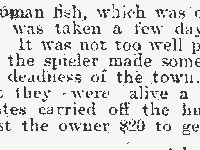- THE HUMAN FISH
- THE HUMAN FISH (follow-up 2 weeks later)
Clifford (1997) mentions “the long history of ‘exotic’ displays in the West. This history provides a context of enduring power imbalance within and against which the contact work of travel, exhibition, and interpretation occurs. An ongoing ideological matrix governs the understanding of ‘primitive’ people in ‘civilized’ places.” (p. 197). He then describes the famous pseudo-exotic performances by CoCo Fusco and Guillermo Gómez-Peña.
When I was collecting data for my M.A. thesis, I found the following newspapers clipping which serve as evidence that the “long history of ‘exotic’ displays in the West” has been part and parcel of everyday life and popular culture too. Not only high-art or museum discourse. I have posted the two 1897 newspaper clippings but since they are a bit hard to read, I also transcribed them below. Enjoy.
Published in the Vancouver Daily World, July 20, 1897, p. 8:
THE HUMAN FISH
The Strange Amphibian From the Southern Coast Reaches Town.
The remarkable amphibian so fully described in recent press dispatches, has reached town. Capt / Robt. Beasley, its custodian, is en route to the east with his strange charge, which is attracting the curious wherever exhibited. In formation it strikingly resembles the analomy of a female human in the working in the upper half of its anatomy. From the waist downward the extremity is that of an ordinary fish. Showing the scales, dorsal and candal fans. It was captured alive in the Gulf of California by native fisherman and is now attracting crowds of visitors to the Boulder block, on Cordova street, where it is being exhibited.
Published in the Vancouver Daily World, August 2, 1897, p. 8:
The human fish, which was on exhibition here, was taken a few days ago to Steveston. It was not too well patronized there and the spieler made some remarks about the deadness of the town. Just to show that they were alive a couple of Stevestonites carried off the human fish and it cost the owner $20 to get it back again.



Claude, this is an interesting little moment in Vancouver history. What strikes me in the context of Clifford’s ‘contact zone’ is actually how the catching of this strange creature by First Nations fishermen brought Indigenous and Settler worlds into proximity and exchange through the exhibition and subsequent story-telling/publicizing of the ‘human fish’. I wonder what the fishermen thought of the creature when they caught it… was it an opportunity to make more money than usual? Did the settler/European fascination with the mermaid have an analogue in Indigenous mythologies? Who did they bring it to to negotiate its exhibition? How did it end up in Vancouver after being caught in California waters? Like Clifford’s description of Tlingit elders in the Portland Art Museum, and the ways in which objects themselves were secondary to the stories and political negotiations that they elicited, I can’t help thinking about the human fish as one small part of a large web of cultural, political, historical and colonial relationships….